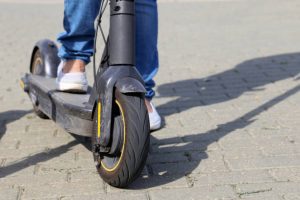Are you tired of bumpy and unsafe rides on your scooter? Don’t worry; FamilyHype has got you covered! In this article, we will guide you through replacing your scooter wheels to ensure a smooth and safe ride every time.
Maintaining your wheels is essential for your safety and the overall performance of your scooter. Worn-out wheels can affect your balance and control, making your rides uncomfortable and potentially dangerous. That’s why it’s essential to choose the right wheels – ones that are durable, reliable, and suitable for your riding style.

When it comes to replacement, replacing your wheels may sound daunting, but don’t worry – we’ve got you covered. We will provide step-by-step instructions on replacing them, making it hassle-free. We will also discuss how to maintain and extend the lifespan of your wheels, ensuring that they serve you well for a long time.
Let’s dive in and ensure you have a smooth and safe ride on your scooter!
We would love to hear your feedback and experience with replacing your wheels. Share your opinions and reviews with us and help others have a safe and comfortable ride.
Key Takeaways
- Maintaining scooter wheels is crucial for safety and performance, as worn-out wheels can affect balance, control, and ride comfort.
- Choosing durable and suitable wheels for your riding style is important for optimal performance and stability.
- Regular maintenance and replacement of damaged wheels are necessary to ensure a smooth and safe ride.
- Proper inflation, regular cleaning, and wheel alignment are essential for preventing wheel problems and maximizing scooter performance.
Importance Of Proper Scooter Wheel Maintenance
To maintain a smooth and safe ride, it’s important to regularly inspect your scooter’s wheels for any signs of wear or damage. Look for uneven tread wear, cracks, or bulges on the tires. These can indicate the need for wheel replacement. Additionally, check the front wheel bearings for any play or noise, as worn-out bearings can affect the scooter’s performance.
Wheel alignment, including the alignment of the tire gs, plays a crucial role in performance. Misaligned wheels can result in poor handling, instability, and increased tire wear. To ensure proper alignment, check the alignment of the front and rear wheels. Adjust the alignment if necessary by loosening the wheel bolts and realigning the wheels to ensure they are parallel and straight. Proper alignment will enhance stability and maneuverability, providing a smoother and safer ride.

By prioritizing proper wheel maintenance and addressing any issues promptly, you can ensure a smooth and safe ride, prolong the lifespan of your scooter’s wheels, and optimize its overall performance.
Choosing The Right Wheels For Your Scooter
Choosing the right wheels set for your razor scooter is crucial to ensure optimal performance and a comfortable ride. Here are some factors and details to consider when selecting wheels:
- Wheel Size: The size of the wheels can impact the ride quality and stability of your scooter. Larger wheels provide a smoother ride and better maneuverability over rough terrain, while smaller wheels offer more agility and responsiveness.
- Wheel Material: Scooter wheels are typically polyurethane (PU) or rubber. PU wheels are known for their durability, grip, and shock absorption, making them suitable for various riding conditions. Rubber wheels offer a softer ride and better traction but may wear down faster.
- Wheel Hardness: Wheel hardness is measured on a durometer scale, typically ranging from 78A to 100A for scooters. Softer wheels (lower durometer rating) provide better grip and shock absorption but may wear down more quickly. Harder wheels (higher durometer rating) offer increased speed and durability but may provide a less comfortable ride.
- Wheel Profile: The wheel’s profile refers to its shape, which can vary from flat to rounded. Flat-profile wheels offer more stability, especially for tricks and jumps, while rounded-profile wheels provide smoother turns and better maneuverability.
- Riding Style: Consider your riding style and preferences when choosing wheels. Harder and smaller wheels may be more suitable if you primarily ride on smooth surfaces or perform tricks and stunts. Larger, softer wheels with good tread patterns can enhance traction and stability for off-road or rough terrain riding.
Before purchasing, check your scooter’s compatibility with different wheel sizes and axle widths. Consulting with a knowledgeable scooter retailer or manufacturer can help you select the right wheels that meet your needs and preferences.
How To Replace Scooter Wheels
Replacing replacement wheels for your kick scooter is a relatively straightforward process. Here are the general steps to follow when replacing your scooter wheels:
- Gather the necessary tools: You’ll typically need a wrench or Allen key that fits the axle nut or bolt holding the wheel in place. Check the specific requirements of your scooter to ensure you have the correct tools.
- Remove the old wheel: Use the wrench or Allen key to loosen and remove the axle nut or bolt that secures the wheel. Once the nut or bolt is removed, carefully slide the old wheel off the axle.
- Prepare the new wheel: If your new wheel is not preassembled, you may need to insert bearings into the wheel if not installed. Follow the manufacturer’s instructions for proper bearing installation.
- Install the new replacement wheels: Align the new wheels with the axle and slide it onto the axle shaft. Make sure the wheel sits securely against the scooter’s fork or frame. If a spacer or washer is provided with the wheel, ensure it is properly positioned.
- Secure the wheel: Tighten the axle nut or bolt with the wrench or Allen key, ensuring the wheel is securely fastened to the scooter. Be careful not to overtighten, as this may cause damage to the wheel or axle.
- Test the wheel: Give the scooter a gentle push or roll it forward to confirm that the new wheel spins freely and does not wobble. Ensure that the wheel rotates smoothly and is properly aligned.
- Repeat the process: If you need to replace multiple wheels, repeat the steps for each wheel.

It’s important to consult the specific instructions provided by the manufacturer for parts, as the process may vary slightly depending on the model and wheel type. If you are unsure or uncomfortable with replacing the wheels, it is recommended to seek assistance from a professional or experienced technician.
Maintaining And Extending The Lifespan Of Your Scooter Wheels
Maintaining and extending the lifespan of your scooter wheels and bearings is key to ensuring you have a top-notch riding experience. To do this, you should regularly check for any signs of wear and tear, such as cracks or flat spots, and promptly replace damaged wheels.
Additionally, you should ensure that your wheels are properly inflated and regularly clean them to prevent dirt and debris buildup, which can lead to common wheel problems. This applies to all scooter types, excluding gas-powered scooters.
We hope this article has provided you with all the necessary information to maintain and extend the lifespan of your wheels.
Conclusion
By prioritizing proper scooter wheel maintenance and addressing any issues promptly, you can ensure a smooth and safe ride, prolong the lifespan of your scooter’s wheels, and optimize its overall performance.
Choosing the right wheels for your scooter is crucial, considering factors such as size, material, hardness, and profile.
Replacing scooter wheels can be done by following simple steps, and it’s important to consult the specific instructions provided by the scooter manufacturer.
Regularly checking for signs of wear, properly inflating the wheels of your electric scooter, and cleaning them can help maintain and extend their lifespan.
Maintaining and caring for your scooter wheels and accessories will enhance your riding experience, improve safety, and ensure that you can enjoy a smooth and comfortable ride every time.
So, don’t overlook the importance of proper scooter wheel maintenance, and choose the right wheels to keep your scooter rolling smoothly on any terrain.
